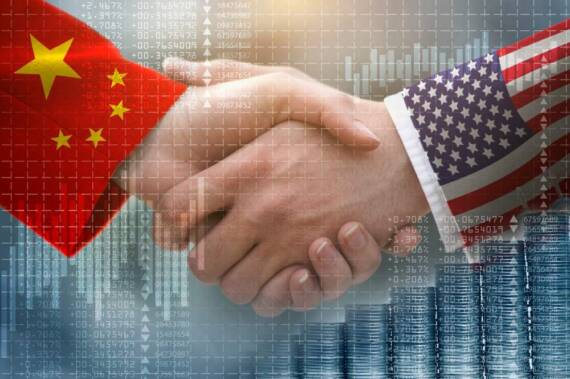The Complete Guide to Chinese Tea
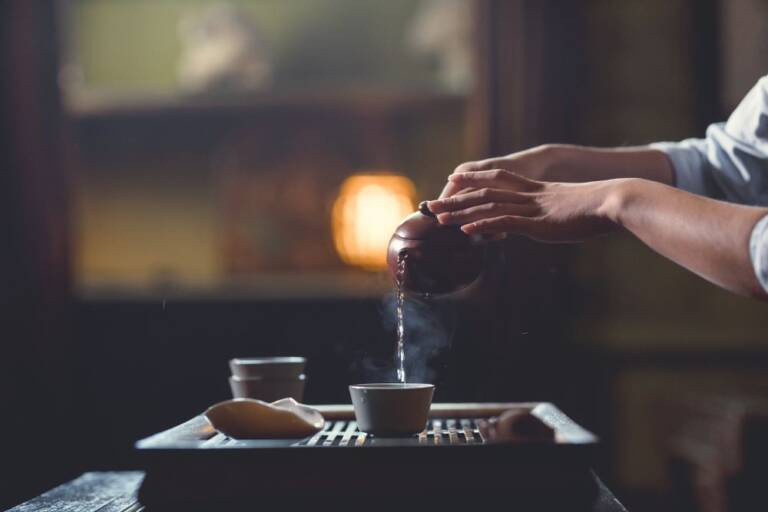
Chinese tea isn’t just a beverage, it’s a historical saga brewed in a cup. With a history dating back thousands of years, Chinese tea is vital to the country’s culture and traditions.
Chinese tea is a symbol of hospitality, a means of social interaction, and a conduit to a peaceful mind. From the elaborate tea ceremonies to the humble tea houses, each aspect of Chinese tea culture is a narrative in itself. This guide aims to explore Chinese tea, including its varied types, traditional practices, and its contemporary global influence. So stick the kettle on, sit back, and let’s get into it.
Not that bothered about tea? Why not read about how to drink booze like a local with our guide to China and alcohol?
The history and evolution of Chinese tea
The tale of Chinese tea began in ancient China, marked by its serendipitous discovery by Emperor Shen Nong in 2737 BC. According to legend, while the Emperor was boiling water under the shade of a wild tea tree, a whimsical breeze ushered tea leaves into his pot.
The infusion of the leaves with the boiling water birthed the first-ever cup of Chinese tea, an event that was to steep through the annals of Chinese history. This simple yet profound incident, even if it’s not exactly grounded in fact, didn’t just give birth to a beverage but a rich tradition that would come to be revered across the globe.
The art and etiquette of brewing and drinking tea soon intertwined with the cultural, social, and even spiritual fabric of ancient China, seeding a tradition that was to flourish over millennia.
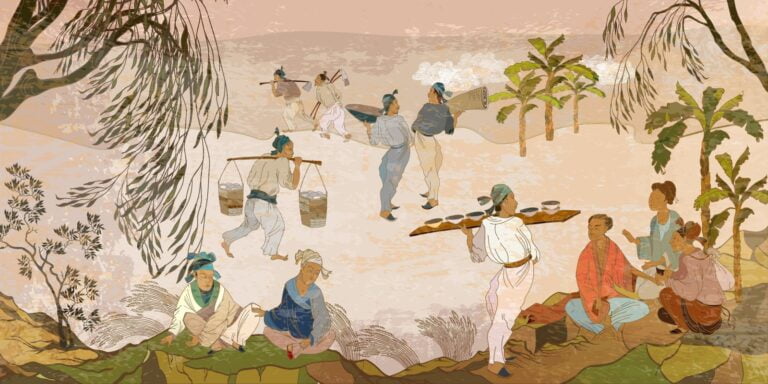
As time meandered through the dynasties, so too did the tale of Chinese tea, brewing through the veins of Chinese civilization. From being a concoction of medicinal allure to a symbol of status and hospitality, tea became an emblem of the Chinese ethos.
The evolution of tea mirrored the unfolding of China’s own historical saga, each dynasty contributing its own unique flavor to the ever-brewing story of Chinese tea culture. The humble leaf that once chanced upon Emperor Shen Nong’s pot grew into a tradition, a science, and an art, encapsulating within its tender green folds the soul of a civilization.
Related Reading: Why Learn Mandarin Chinese?
Evolution over the centuries
Over the ages, the intricacies of tea cultivation and brewing in China grew into a revered art form intricately entwined with the social and cultural ethos of the nation. Initially cherished for its medicinal properties, the humble tea leaf soon found its way to the heart of Chinese nobility, morphing into a symbol of status and elegance.
The traditional Chinese tea ceremonies, a dance of grace, patience, and reverence, emerged as a social conduit, fostering connections amid the aroma of freshly brewed tea. Each dynasty left its imprint on the tea culture, refining the cultivation techniques, expanding the repertoire of tea varieties, and honing the aesthetic of tea consumption.
The worlds of poetry, philosophy, and art found a muse in the delicate nature of Chinese tea, further entrenching it within the cultural fabric of China.
As history moved on, so too did accessibility, with tea seeping into the daily lives of the masses. What was once a privilege of the nobility gradually became the soul of everyday social interactions. The modern era saw the proliferation of tea houses (more on those later), making tea an accessible daily pleasure for the common folk.
Related Reading: Is Chinese Hard to Learn?
Introduction of Chinese tea to other parts of the world
The allure of Chinese tea began its journey across borders via the ancient trade routes of the Silk Road, weaving a path of aromatic intrigue through continents. This serene yet potent elixir carried a refreshing taste and traditions reflective of the ancient Chinese civilization.
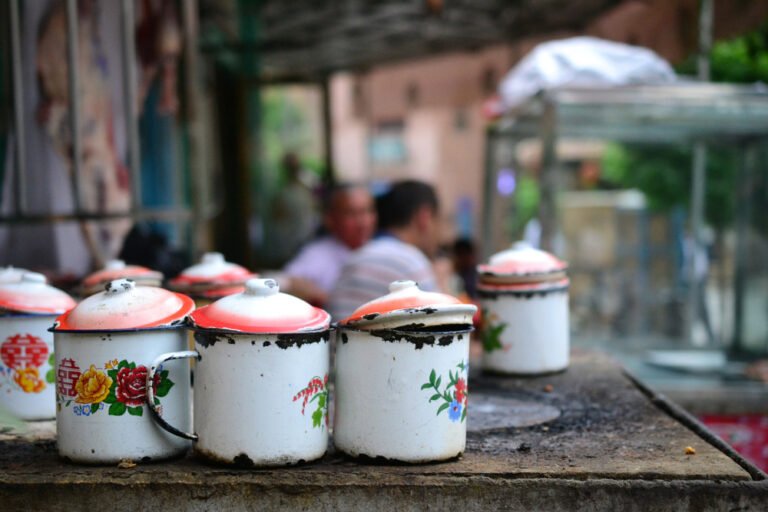
Traders, travelers, and connoisseurs carried tales of this exquisite beverage and its leaves, sowing seeds of curiosity and appreciation in every land they passed through. The tea houses along the Silk Road became cultural melting pots, where the art of Chinese tea brewing mingled with foreign influences — each sip telling tales of distant lands and ancient traditions.
This exchange began a global dialogue, where the essence of traditional Chinese tea began to steep into the global consciousness, fostering a shared appreciation for the nuanced art of tea brewing and consumption.
As the whispers of Chinese tea’s calming and rejuvenating properties reached distant shores, it launched a global tea culture that now stands as a testament to China’s ancient tea traditions. The world began to emulate the reverence with which Chinese tea was cultivated, brewed, and consumed, embedding elements of these ancient traditions within new cultural contexts.
Today, the global tea culture is rich with the influence of Chinese tea traditions, from the complex brewing processes to the ceremonial consumption. Chinese tea houses and traditional Chinese tea ceremonies have found a place in the global arena, offering a tranquil respite amid the chaos of modern life.
Related Reading: 22 Good Chinese TV Shows to Learn Mandarin
Types of Chinese tea
China boasts a diverse array of tea types, each bearing a unique character and a tale of the land it hails from. Step into a world where every brew tells a story of ancient traditions and craftsmanship.
Green tea
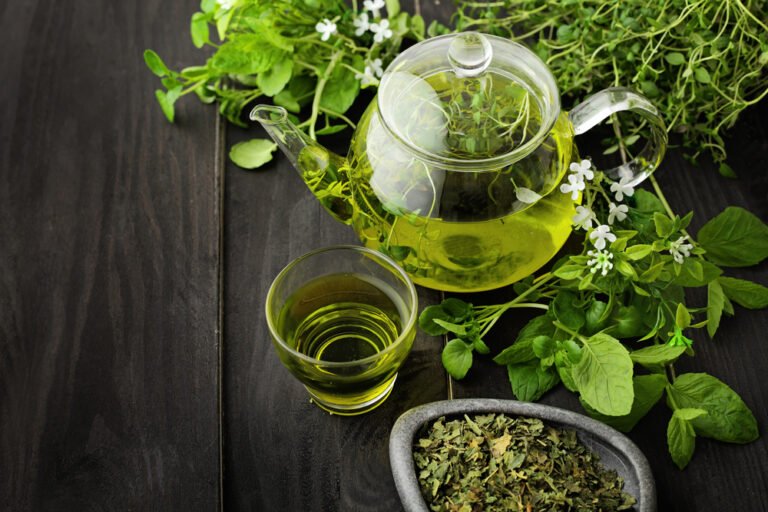
Green tea is a hallmark type of Chinese tea, which is renowned for its minimal oxidation, embodying a fresh, green character reflective of spring’s youthful vigor. The delicate taste and the tranquility it brings to the tea table make it a cherished choice among tea enthusiasts, offering a gentle introduction to the expansive world of Chinese tea.
Popular varieties
Longjing (Dragon Well), Biluochun, and Huangshan Maofeng are among the most famous green tea varieties from China — each with a unique flavor profile and history.
Oolong tea
Rooted deeply within Chinese tea culture, oolong tea, a semi-oxidized tea, comes with a complex flavor profile and aromatic allure. Its traditional significance and the artistic finesse required for its preparation make oolong a captivating part of the Chinese tea spectrum.
Popular varieties
Tieguanyin (Iron Goddess of Mercy) and Wuyi Rock teas are among the famous oolong teas from China, known for their exquisite taste and aroma.
Black tea
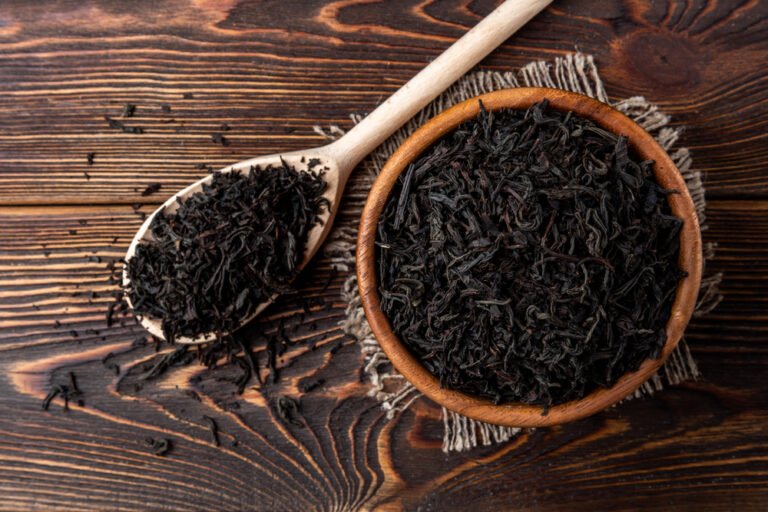
Chinese black tea, known as hong cha, undergoes full oxidation, which gives it a rich, robust flavor. The bold character and the variety within this tea type reflect the diversity and depth of Chinese tea traditions. And no, your PG Tips aren’t the same thing at all!
Popular varieties
Keemun, Lapsang Souchong, and Dian Hong are notable Chinese black tea varieties, each offering a distinct flavor and aroma.
White tea
Celebrated for its delicate flavor and minimal processing, white tea represents the elegance and simplicity most commonly associated with traditional Chinese tea. Its gentle flavor provides a soothing tea experience, embracing the calm serenity of the tea gardens where it originates.
Popular varieties
Bai Hao Yin Zhen (Silver Needle) and Bai Mu Dan (White Peony) are revered white tea varieties from China.
Pu’erh tea
Pu’erh, also known as Pu-er tea or Puerh tea, with its earthy flavor and unique aging process, offers a journey through time. Its ability to evolve and mature makes it a fascinating type of Chinese tea, embodying a living history within each cup.
Popular varieties
Raw and ripe Pu’erh teas are the two main categories, with each having a multitude of varieties based on their age and region of production.
Herbal teas
Chinese herbal teas, crafted from a blend of herbs, flowers, and roots, represent an age-old tradition of harnessing nature’s bounty. These teas echo the ancient Chinese philosophy of harmony between humans and nature, offering a variety of sensory experiences through their diverse flavor profiles.
Popular varieties
Chrysanthemum tea, hibiscus tea, and goji berry tea are popular herbal teas, each carrying its own set of possible health benefits and unique flavors.
Vocabulary guide
Understanding the names of different types of Chinese tea in English and Chinese enriches your exploration of Chinese tea culture. Each term carries a story and tradition from the heart of China’s ancient tea heritage.
| English Term | Chinese Term (Pinyin) | Chinese Characters |
| Green Tea | Lǜ Chá | 绿茶 |
| Oolong Tea | Wūlóng Chá | 乌龙茶 |
| Black Tea | Hóng Chá | 红茶 |
| White Tea | Bái Chá | 白茶 |
| Pu Erh Tea | Pǔ’ěr Chá | 普洱茶 |
| Herbal Tea | Cǎoyào Chá | 草药茶 |
Delve deeper into the linguistic beauty of Chinese tea culture with our innovative language learning method, The Blueprint. Explore our services and accelerate your journey into the aromatic world of Chinese tea.
Chinese tea ceremonies
The Chinese tea ceremony, also known as the Gongfu Tea Ceremony, is a centuries-old tradition that reflects the profound respect and appreciation for tea within Chinese culture.
Literally translated, gong fu cha means making tea with skill!
The ceremony transforms the act of tea brewing and consumption into a spiritual endeavor, encouraging mindfulness and connection among participants. It’s a ritual that emphasizes harmony, peace, and enjoyment, symbolizing a holistic Chinese philosophy toward life and nature.
Process and etiquette
The ceremony is an intricate process requiring a precise set of tools and a meticulous sequence of actions. It begins with selecting the appropriate tea and warming the utensils, followed by observing the leaves as they unfurl and release their aroma during brewing.
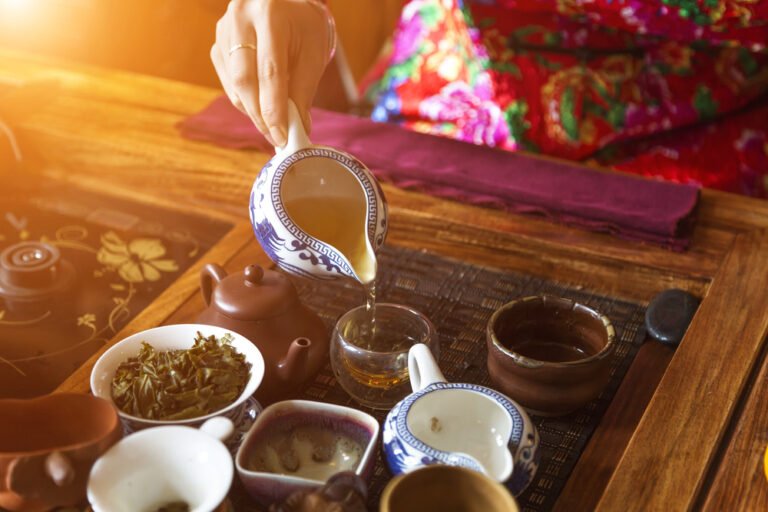
The tea is then poured and savored in a serene, respectful manner. Etiquette is paramount. From the way tea is poured to how it’s sipped, every action is carried out with mindfulness and reverence.
The traditional Chinese tea ceremony is a beautiful blend of art, culture, and linguistic elegance. Familiarity with the relevant terms enhances your appreciation of the ceremony, bridging the gap between mere observation and deeper understanding.
Vocabulary guide
The traditional Chinese tea ceremony is a beautiful blend of art, culture, and linguistic elegance. Familiarity with the relevant terms enhances your appreciation of the ceremony, bridging the gap between mere observation and deeper understanding.
| English Term | Chinese Term (Pinyin) | Chinese Characters |
| Tea Ceremony | Cháyì | 茶艺 |
| Teapot | Cháhú | 茶壶 |
| Teacup | Chábēi | 茶杯 |
| Brew | Pào | 泡 |
| Pour | Dào | 倒 |
Embark on a linguistic journey that complements your exploration of Chinese tea traditions. Learning Chinese using The Blueprint gives you a gateway to a richer appreciation of the Chinese tea ceremony and beyond.
Related Reading: 50 Chinese Slang Words to Make You Sound Like a Native
The role of tea for Chinese New Year and other festivals
Tea plays a crucial role in Chinese festivities, symbolizing respect, gratitude, and good wishes. During Chinese New Year and other significant festivals, it’s a tradition to offer tea to elders and guests as a sign of respect and good fortune.
The act of tea offering is also a way to build relationships and express gratitude. Even the choice of tea and the manner in which it’s served can carry symbolic meanings, contributing to the festive atmosphere and cultural richness of these celebrations.
Everyday tea-drinking culture in China
Tea is more than just a beverage, it’s a medium for social interaction, relaxation, and reflection. Teahouses are ubiquitous, acting as social hubs where people gather to chat, play games, or enjoy a quiet moment with a cup of tea.
The ritual of brewing and savoring tea daily is a cherished practice, reflecting the Chinese philosophy of finding joy and tranquility in life’s simple pleasures. This everyday tea culture is a testament to the enduring love and respect for tea, embodying the ethos of traditional Chinese tea culture in the rhythm of modern life.
Chinese tea gardens
China is home to numerous revered tea gardens, each with unique charm and historical significance. Notable gardens include the West Lake Longjing Tea Garden in Hangzhou, known for its premium Longjing (Dragon Well) tea, and the Wuyi Mountains, a UNESCO world heritage site famed for its rock oolong teas.
The high-altitude Mengku Tea Garden in Yunnan is renowned for its ancient tea trees that produce prized Pu’erh tea. These gardens are not just cultivation sites but a living testament to China’s rich tea heritage, their unique geographical and climatic conditions imparting distinct flavors and qualities to the teas they produce.
Related Reading: Can You Learn Chinese in 5 Minutes?
Chinese tea houses and restaurants
Chinese tea houses have a history dating back to the Tang Dynasty. Over centuries, they evolved from simple establishments to places of social, cultural, and intellectual exchange. They weren’t just spots for sipping tea but venues where people gathered for social interaction, entertainment, and business dealings.
The traditional Chinese tea house mirrored Chinese society, acting as a social equalizer where people from various strata could enjoy a cup of tea, engage in conversation, or simply find a moment of tranquility.
Over time, these tea houses have witnessed the ebbs and flows of China’s historical and social tide, each era leaving its imprint on the tea house culture.
Modern-day tea houses and Chinese tea restaurants
Today, modern tea houses and Chinese tea restaurants offer a blend of traditional and contemporary experiences. They continue to serve as social hubs, offering a variety of Chinese teas, traditional snacks, and often meals.
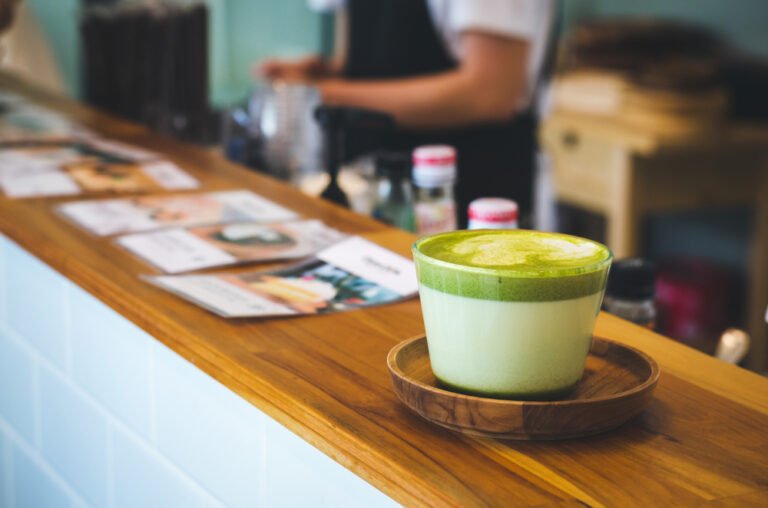
Many provide cultural experiences like traditional tea ceremonies, live music, and performances, creating a rich, immersive atmosphere for patrons. Chinese tea restaurants extend the tea experience to the dining table, where tea is a central part of the culinary journey, either through tea-infused dishes or as a complimentary beverage to the meal.
Through a blend of old and new, these modern establishments offer a warm invitation to experience the rich tapestry of Chinese tea culture.
Related Reading: How to Order Chinese Food in a Chinese Restaurant
Unique Chinese teas
These unique teas, with their distinctive flavors and cultural significance, offer something far beyond their aromatic allure. They embody the spirit of exploration and the timeless heritage of Chinese tea culture. Discover the unexplored, savor the renowned, and immerse yourself in the rich and unique Chinese teas that await.
Jasmine Chinese tea
Jasmine Chinese Tea is a fragrant blend where green tea leaves are infused with the essence of jasmine flowers. The delicate, floral aroma of jasmine paired with the refreshing taste of green tea creates a soothing and aromatic beverage. This tea is cherished not only for its delightful scent and flavor but also for its apparent health benefits. Its calming effect also makes it a preferred choice for relaxation and stress reduction.
Chinese gunpowder tea
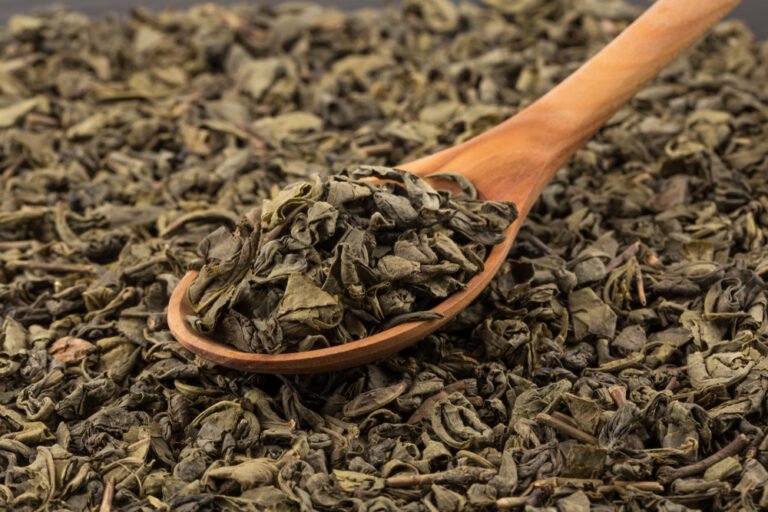
Known for its unique appearance and robust flavor, Chinese gunpowder tea is a form of green tea where the leaves are rolled into small, round pellets resembling gunpowder. The rolling process helps preserve the flavor and aroma of the tea, which unfurls with a bold, slightly smoky taste upon brewing.
The global influence of Chinese tea
The global tea culture has been significantly colored by the traditions and varieties of Chinese tea. As one of the ancient cradles of tea cultivation, China’s methods of tea processing, brewing, and consumption have traveled far and wide, inspiring tea practices across different cultures.
Today, Chinese tea varieties like green tea, oolong, and black tea are staples in the tea repertoire of many cultures, and the philosophies embedded in Chinese tea culture continue to resonate globally, promoting notions of mindfulness, community, and a harmonious existence with nature.
Related Reading: Best Resources for Learning Chinese
How to enjoy Chinese tea at home
Each type of Chinese tea has its own unique brewing technique that helps bring out its best flavors and aromas. Let’s break it down a bit.
Green tea
- Water temperature: Use water heated to about 150-180°F (65-80°C).
- Steeping time: Allow the tea to steep for 1-3 minutes, depending on how strong you prefer your tea.
- Amount: Use about 1-2 teaspoons of tea leaves per cup of water.
Oolong tea:
- Water temperature: Heat water to about 190-200°F (87-93°C).
- Steeping time: Allow the tea to steep for 3-5 minutes.
- Amount: Use about 1-2 teaspoons of tea leaves per cup of water.
Black tea
- Water temperature: Use boiling water, around 200-212°F (93-100°C).
- Steeping time: Allow the tea to steep for 3-5 minutes.
- Amount: Use about 1 teaspoon of tea leaves per cup of water.
White tea
- Water temperature: Heat water to about 185-190°F (85-87°C).
- Steeping time: Allow the tea to steep for 4-5 minutes.
- Amount: Use about 1-2 teaspoons of tea leaves per cup of water.
Puerh tea
- Water temperature: Use boiling water.
- Steeping time: Allow the tea to steep for 3-5 minutes.
- Amount: Use about 1 teaspoon of tea leaves per cup of water.
Herbal teas
- Water temperature and steeping time: These can vary widely depending on the specific herbs used, so it’s best to follow the instructions provided with your herbal tea.
- Amount: Typically, use about 1 teaspoon of herbs per cup of water.
A journey through leaves
The humble tea leaf has a rich heritage that has simmered through dynasties, traversed along ancient trade routes, and nestled in the heart of communal gatherings.
The aesthetic choreography of tea ceremonies, the tranquil vistas of tea gardens, the welcoming warmth of tea houses, and the global embrace of this aromatic elixir all echo the integral role of Chinese tea in weaving a tapestry of communal ethos, both within China and beyond its borders.
As the steam curls up from a freshly brewed cup, beckoning the curious and the seasoned alike, the invitation to delve deeper into the vast and aromatic world of Chinese tea is ever-present. Each type of Chinese tea is a narrative, each sip is an exploration, and each shared cup is a dialogue. Thirsty?
At Mandarin Blueprint, our language lessons aren’t just about learning Chinese but also about immersing yourself in the culture, which includes the tradition of tea drinking. If you’re interested in finding out more, why not reserve a seat on our free webinar and find out how we can help you learn Chinese three times faster than traditional lessons (and at a fraction of the cost)?
Book your seat now, and you could be speaking Chinese and immersing yourself in Chinese tea culture much faster than you ever thought possible.








